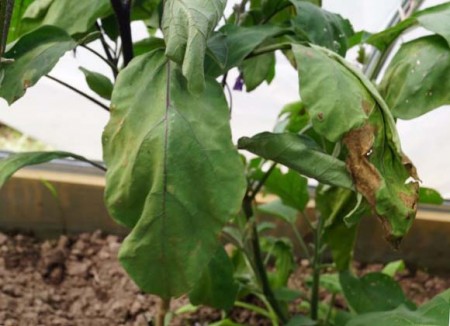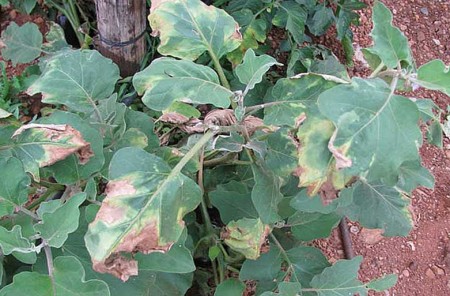“On our eggplants, the leaves wither, turn yellow, and then dry out. What happened to them and can they be saved and what needs to be done.”
This is verticillium wilt. The disease makes itself felt during the period of budding and flowering. The upper part or edges of the lower leaves between the veins turn pale and begin to wither. Later the entire leaf withers and dries up. Gradually the disease spreads higher and higher. Only the very top remains alive.
The pathogens remain viable in the soil for up to 15 years. Infection occurs through wounds obtained when planting seedlings and loosening the soil. Penetrating into the conducting system, fungi clog it or destroy it with their toxic secretions. The disease progresses at relatively high temperatures. By autumn, when it gets colder, the plants can recover and even produce side shoots in place of wilted leaves.
What to do. How to stop the development of the disease?
Keep the soil loose and moderately moist. Spray the plants and water the soil in the root zone with a solution of phytosporin-M or alirin-B. At the end of the season, collect and destroy all plant debris. Return nightshade crops to this place (not only eggplants, but also peppers, tomatoes, physalis) no earlier than after 4-5 years. If this is not possible, sow the area with grain green manures (rye, winter wheat, oats), which are not host plants for the Verticillium wilt pathogen.



 CUCUMBERS NEVER GET SICK, I'VE BEEN USING ONLY THIS FOR 40 YEARS! I SHARE A SECRET WITH YOU, CUCUMBERS ARE LIKE THE PICTURE!
CUCUMBERS NEVER GET SICK, I'VE BEEN USING ONLY THIS FOR 40 YEARS! I SHARE A SECRET WITH YOU, CUCUMBERS ARE LIKE THE PICTURE! You can dig a bucket of potatoes from each bush. Do you think these are fairy tales? Watch the video
You can dig a bucket of potatoes from each bush. Do you think these are fairy tales? Watch the video
 How our fellow gardeners work in Korea. There is a lot to learn and just fun to watch.
How our fellow gardeners work in Korea. There is a lot to learn and just fun to watch. Eye trainer. The author claims that with daily viewing, vision is restored. They don't charge money for views.
Eye trainer. The author claims that with daily viewing, vision is restored. They don't charge money for views. A 3-ingredient cake recipe in 30 minutes is better than Napoleon. Simple and very tasty.
A 3-ingredient cake recipe in 30 minutes is better than Napoleon. Simple and very tasty. Therapeutic exercises for cervical osteochondrosis. A complete set of exercises.
Therapeutic exercises for cervical osteochondrosis. A complete set of exercises. Which indoor plants match your zodiac sign?
Which indoor plants match your zodiac sign? What about them? Excursion to German dachas.
What about them? Excursion to German dachas.